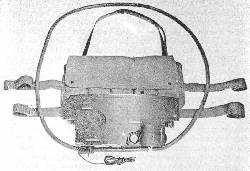 |
 |
 |
The Gürtelpeilgerät (belt-worn direction-finding apparatus) was a small, portable, tuneable RDF-intercept receiver developed during WW2 for the German Ordnungspolizei (city police public-safety unit). Its main application was close-in detection of clandestine transmitters.
This unusual set was featured on a British 5-part mini-series on the SOE(Special Operations Executive), which was broadcast about two years ago on Canada's History Television channel. The series comes up from time to time on the US History Channel.
One episode went into the SOE's clandestine wireless communications fromoccupied Europe in quite a bit of detail. The agents used attaché-case HFtransceivers (such as the B2) which were a technological marvel for thatera. These radios had 10 to 20W RF output, and put in a good CW signal in England. A German engineer named Meyer developed RDF and detection techniques whichwere so successful that similar methods are still in use. A Funkpeilwagen (RDF van)was usually a van with a wooden superstructure concealing the DF antenna.The wood offered minimal attenuation to the signal.
SOE wireless ops were under standing orders to limit transmissions to nomore than 5 minutes, though many of them stayed on for far too long. Germanfixed monitoring stations would triangulate the signal source to within 2 -3 km, and then the Funkpeilwagen would be sent into the general area. Onceit got an accurate bearing, an operator would get out and walk around with the Gurtelpeilgerät handheld/body-worn RDF receiver. (Ref. 3, p. 71-75).
The set was a sophisticated, miniaturised 7-tube superhet covering 3 - 20 MHz. It displayed the signal strength, and also demodulated the signal to allow the operator to listen. When he got really close to the building housing the clandestine transmitter, the operator would be able to hear the sideband noise of the transmitter by tuning off-frequency. (This is a very sophisticated technique even by today's standards.)
The German RDF operator would then go to the electrical service panel of thebuilding. Either by watching the rotation of the electricity-meter disc (itwould pulsate with the keying), or by switching off the mains to eachapartment in turn until the signal disappeared, he would have his quarry.The former method was preferred, as it would not alert the luckless wirelessop. However, if other loads (e.g. a stove) were causing the meter disc toturn fairly fast, this would mask the varying demand of the transmitter. IfI recall correctly, the FBI also utilised this method during WW2 to capture enemy wireless ops in New Jersey or New York State.
The wireless ops became fairly adept at countermeasures. When the lightswent out, the op would not resume when the mains went back on. Alternatively,he would power the set off a car battery, Also, the operators used to change frequency in the middle of a transmission, according to a prearranged schedule. (Changing frequency involved changing a quartz crystal and plug-in coil, and resetting tuning knobs to a preset mark). Otherwise, another op 10 to 20 km away might pick up the transmission on a different frequency.
SOE "borrowed" huge directional transmitting antenna arrays from the BBC'sshort-wave services, as these had 10 to 12 dB gain. This was a big help whentrying to pull out a 20W signal transmitted via an indoor random-wire antenna.(Ref. 10)
German RF engineers developed the world's first RF spectrum analysers to aid in spotting and characterising clandestine signals. (Ref. 3, p. 36-40). The German radioindustry also produced several intercept receivers (Funkhorchempfänger, orFuHE)covering HF and VHF ranges. These receivers acquit themselves very well even by present-day standards. (Ref. 3, Chapter 1.3 and Ref. 9)
The movie "The Looking-Glass War" has a sequence at the end in which the DDR-Funkpeildienst (former East German RDF service) catch the poor, miserable amateur agent by using the techniques described above.
Incidentally, in wartime Britain, a Post Office Radio Branch permit wasrequired for the purchase of an audio output tube from a wireless shop.Applying for the permit triggered a background check; several enemy agents were caught that way, trying to buy such tubes for use in clandestine transmitters.
| SSB in 1931: In order to reduce interference susceptibility on overseas HF radiotelephone circuits, the Deutsche Reichspost (precursor of today's Deutsche Telekom) had already inaugurated SSB traffic between Berlin and New York in 1931, as proposed by Dr. W. Runge of the firm Telefunken. In addition, the Siemens EB1/3A SSB/ISB adapter "Käthe" (1944/45) for the Fu.H.E.c intercept receiver and the famous Telefunken E52 "Köln" receiver was also used occasionally for radio intercept applications. This is a remarkable, if relatively unknown milestone in the history of radio technology. (Ref. 3, p. 35 and Ref. 8) |
References: (Some publications available from DL6VW)
Copyright © 2003-2009 A. Farson VA7OJ/AB4OJ. All rights reserved.
Photo courtesy Louis Meulstee PAØPCR. Page last updated: 09/25/2019.